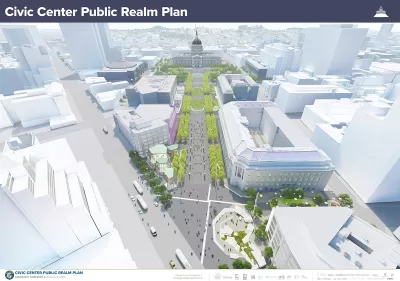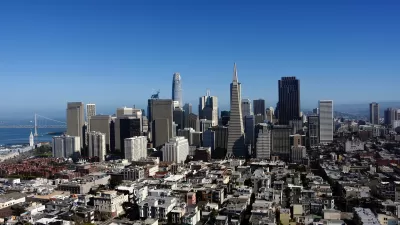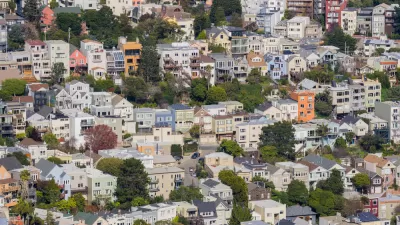The city of San Francisco is proposing an ambitious renovation of its Civic Center—the series of public spaces connecting Market Street to City Hall.

The San Francisco Planning Department recently revealed conceptual designs for a major renovation of the Civic Center. San Francisco Chronicle Architecture and Urban Design Critic John King has a review, which commences with this summary:
San Francisco’s new vision for the core of Civic Center strikes an ambitious, inventive balance between Beaux-Arts grandeur and small-scale welcome. The present and the past.
This doesn’t mean it is flawless. Or that design alone can solve the social challenges that now mar the procession of spaces from City Hall east to Market Street. But it’s a provocative starting point if we’re to be serious about the troubled district’s long-term health and not just pushing squalor out of sight.
One potentially controversial piece at the center of the Civic Center is the United Nations Plaza, designed by Lawrence Halprin. King reports that "United Nations Plaza would keep its current form, and the granite slab-studded fountain designed by Lawrence Halprin would stay. However, the fountain would be altered so as to make passage through it accessible to people with disabilities."
Right now, city planners are hoping to achieve the ambitious menu of changes proposed in the conceptual designs in phases. "There’s plenty more to do, no question," writes King to conclude. "If work does proceed — to environmental studies later this year and then the search for funding — design details are certain to change."
FULL STORY: SF Civic Center’s new vision: soccer fields, shaded gardens and people

Trump Administration Could Effectively End Housing Voucher Program
Federal officials are eyeing major cuts to the Section 8 program that helps millions of low-income households pay rent.

Planetizen Federal Action Tracker
A weekly monitor of how Trump’s orders and actions are impacting planners and planning in America.

Ken Jennings Launches Transit Web Series
The Jeopardy champ wants you to ride public transit.

Crime Continues to Drop on Philly, San Francisco Transit Systems
SEPTA and BART both saw significant declines in violent crime in the first quarter of 2025.

How South LA Green Spaces Power Community Health and Hope
Green spaces like South L.A. Wetlands Park are helping South Los Angeles residents promote healthy lifestyles, build community, and advocate for improvements that reflect local needs in historically underserved neighborhoods.

Sacramento Plans ‘Quick-Build’ Road Safety Projects
The city wants to accelerate small-scale safety improvements that use low-cost equipment to make an impact at dangerous intersections.
Urban Design for Planners 1: Software Tools
This six-course series explores essential urban design concepts using open source software and equips planners with the tools they need to participate fully in the urban design process.
Planning for Universal Design
Learn the tools for implementing Universal Design in planning regulations.
Heyer Gruel & Associates PA
Ada County Highway District
Institute for Housing and Urban Development Studies (IHS)
City of Grandview
Harvard GSD Executive Education
Toledo-Lucas County Plan Commissions
Salt Lake City
NYU Wagner Graduate School of Public Service





























